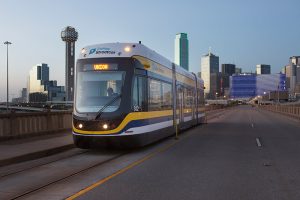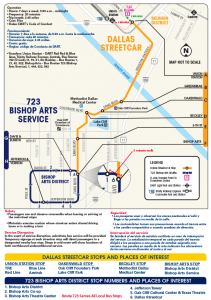The Dallas Streetcar operates along a 2.45 mile line between downtown Dallas and the historic Oak Cliff neighborhood. It is free to ride and operates seven days a week from 5:30 am to midnight. The streetcar line was completed in two separate phases. The first phase opened on April 13, 2015 and the second phase started operating less than a year and a half after the first phase on August 29th, 2016. The city is looking at future plans to extend the streetcar. (Wikipedia)
The streetcar line was built as a combined effort between the “City of Dallas, the North Central Texas Council of Governments (NCTCOG), the Dallas Area Rapid Transit (DART), and the Federal Transit Administration (FTA)” (DART). A $23 million Transportation Investment Generating Economic Recovery (TIGER) grant was received for the streetcar project from the FTA. As a requirement for funding through the grant, an Environmental Assessment was completed. The FTA adopted the assessment and a re-evaluation citing “no significant adverse impacts on the environment” (Federal Transit Administration) would occur as result of construction and operation of the streetcar line. An additional $3 million in federal funding was received along with $31 million in state funding and $22 million in local funding for a total of $79 million in funding. An additional $27.5 million in grant money was allocation for phase two. The streetcar costs $2 million a year to operate and it is funded by a subsidy from the city. The streetcar is currently free to ride. The Oak Cliff Advocate Magazine reports early ridership on the phase one route was between 150-300 riders a day, current ridership information is not available.
A map of the streetcar line from DART shows that the streetcar has six stops along the line. The northern point of the line is a five minute walk from Union Station where users can access the DART Rail, Trinity Railway Express, Amtrak, and five bus routes. Two other stops allow transfers to bus routes, four transfers at the Beckley stop and five transfers at the Bishop Arts stop.
The Dallas streetcar is a hybrid streetcar. Mass Transit Magazine describes the hybrid streetcar as being “designed with a battery, which allows for the streetcar to go off-wire in places.” The streetcar passes over the Houston Viaduct Bridge using battery power versus overhead lines. The viaduct had historic restrictions causing a need for alternatives to placing overhead wiring infrastructure. (Bucher)
The Dallas Comprehensive Plan adopted in 2006 encourages “a variety of transit options and technologies” continuing with implementation measures that “explore public-private partnerships to fund and implement lower-cost transit options such as a modern streetcar and bus rapid transit” and to “explore ways to effective integrate new transit systems, such as a modern streetcar and bus rapid transit”. The Neighborhood Plus plan does not include the neighborhoods that the streetcar line runs in. The Dallas Complete Streets plan discusses transit priority lanes for streetcars, but does not include discussion on additional streetcar expansion as part of the plan.
Development in Oak Cliff has increased, but an April 2016 Dallas Business Journal article attributes the development to the redevelopment of the Bishop Arts District (the area is included in the phase two extension), with a representative of one development group saying, The development group was attracted to the emerging demographic in north Oak Cliff and the Bishop Arts District, which is a collection of hipsters, the creative class and residents with a social liberal education”. The article discusses development along Fort Worth Avenue which is over two miles from the Bishop Arts District, the southern end of the streetcar line. Another Dallas Business Journal article from March of 2017 attributes a development across the street from the streetcar to a desire for walkable neighborhoods and Bishop Arts being a “unique district that is the result of an organically-grown neighborhood”. While development is occurring on or near the streetcar line, it appears the developments would have occurred without the streetcar.


Sources:
Carlisle, C. (2016, April 15). Redeveloping Bishop Arts District: Breaking down projects in Oak Cliff. Retrieved March 12, 2017, from http://www.bizjournals.com/dallas/print-edition/2016/04/15/redeveloping-bishop-arts-district-breaking-down.html
Carlisle, C. (2017, March 3). Urban-style homes get underway near Dallas’ Bishop Arts District. Retrieved March 12, 2017, from http://www.bizjournals.com/dallas/news/2017/03/03/urban-style-homes-get-underway-near-dallas-bishop.html
Dallas Area Rapid Transit. (n.d.). Retrieved March 12, 2017, from https://www.dart.org/
Dallas Streetcar. (2017, March 08). Retrieved March 12, 2017, from https://en.wikipedia.org/wiki/Dallas_Streetcar
Project Update: Spotlight on Streetcar Development. (n.d.). Retrieved March 12, 2017, from http://www.masstransitmag.com/article/12246782/project-update-spotlight-on-streetcar-development
Stone, R. (2016, May 11). City Council approves $1.2 million for streetcar cost overruns. Retrieved March 12, 2017, from http://oakcliff.advocatemag.com/2016/05/city-council-approves-1-2-million-streetcar-cost-overruns/
Welcome to the City of Dallas, Texas. (n.d.). Retrieved March 12, 2017, from http://dallascityhall.com/